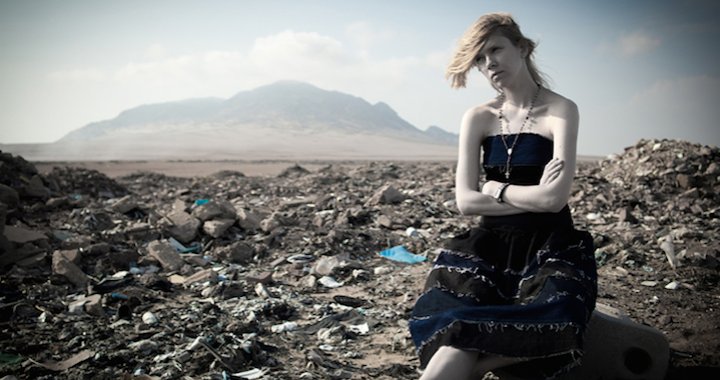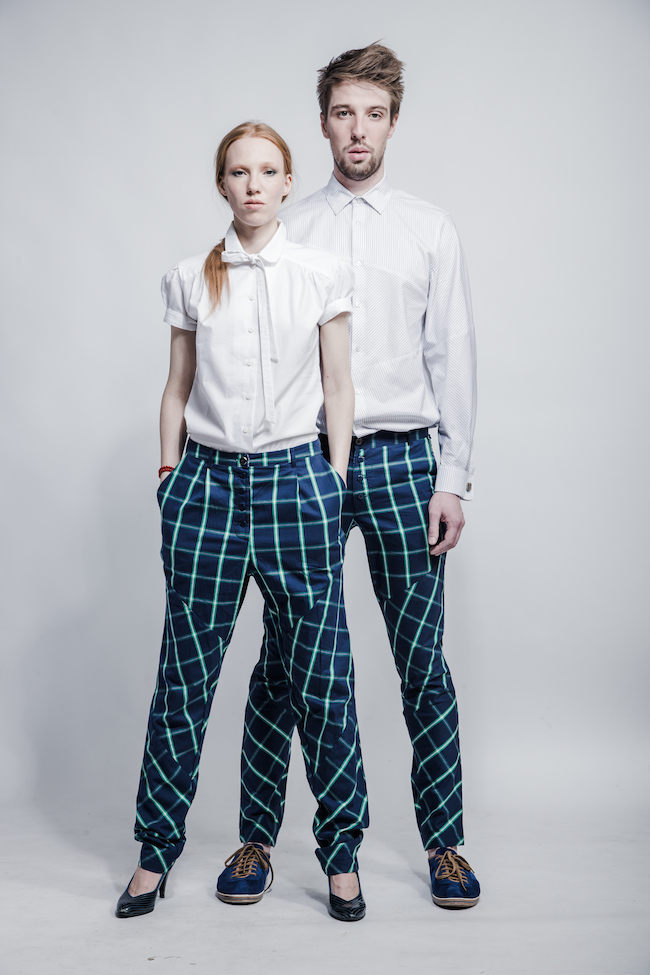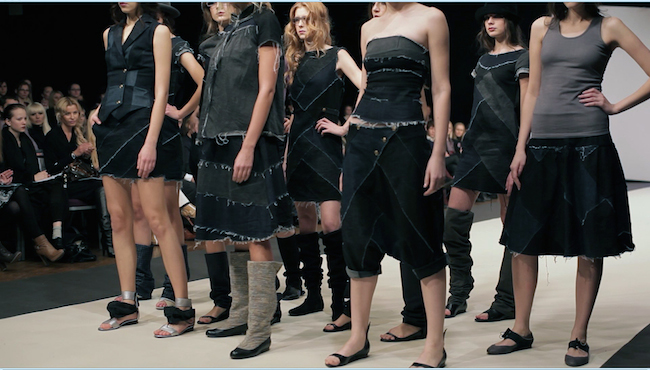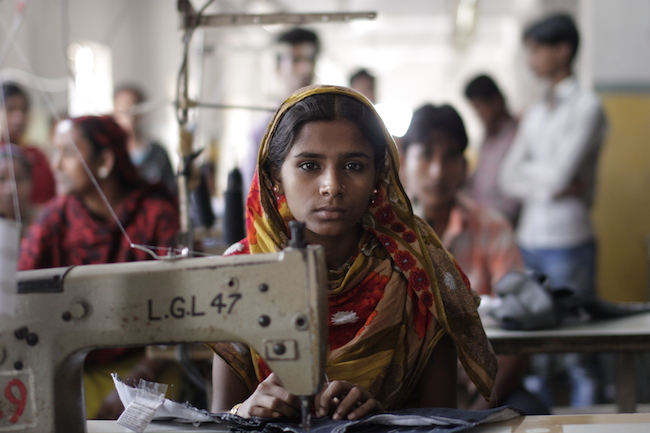
Upcycling as a fashion philosophy
30/09/2015
This year the Estonian Academy of Arts became the first educational institution in the Baltic States to introduce a department of sustainable design. It’s still in the pilot project stage, but the Academy hopes that by next year it will be able to welcome students from abroad. Well-known Estonian fashion designer Reet Aus is one of the department’s initiators. Aus has been working in the so-called upcycling niche of fashion since 2002, which means that her clothing collections are made of manufacturing waste, or industry leftovers. Even though this branch of fashion is becoming increasingly popular in the present age of green thinking, Aus is still the only designer in Europe who has managed to turn upcycling into a mass production enterprise, albeit a small one.

Photo: Herkki Erich Merila
For several years now, Aus has worked together with the Beximco factory in Bangladesh to produce collections made of the leftovers from Zara, H&M, Tommy Hilfiger, Calvin Klein and other well-known fashion brands whose products are made there. “There are no more garment factories in Europe anymore,” says Aus. “Most of the mass production now takes place in Bangladesh, and that’s the main source of income for that country. There are over a thousand such factories in the capital, Dhaka, alone. Both legal and illegal ones. When they place their semiannual orders, companies like Zara, H&M or Calvin Klein don’t think much about what happens with their leftovers. The fast-fashion mill just turns too quickly.”
Aus continues: “Some of the factories try to sell the leftovers on the black market. It’s illegal, though, and no one talks about it. Or they burn the leftovers or just throw them away. Usually they end up somewhere in the environment because the country doesn’t have a system of waste management. Beximco alone produces more than 240 million garments per year. Roughly 20 percent become waste, and there’s always a very big overproduction as well. And, of course, they can’t act as waste managers themselves. With our production we’re able to use only a really small amount of leftovers. But in the ideal world, upcycling could be a very natural part of the whole production process. For example, if Calvin Klein orders a million men’s shirts, the leftovers from the production process can be used to make another 35,000 shirts. It’s just a matter of design and organization. And it’s good for everyone. The brand could get more items out of the same amount of fabric, the producer wouldn’t have to deal with the leftovers, and, compared with a newly made product, making an upcycled shirt uses 90% less water and 80% less energy.”

Photo: Herkki Erich Merila
Reet's knows from experience that the greatest amounts of production leftovers are fabrics made of jersey and denim (i.e., jeans material). “Often there are cases in which the manufactured fabric doesn't match up with the client's wishes, and 800 or more meters of fabric just goes to waste!”
“The Spanish company Inditex was the first to implement the practice of locating the manufacturing process where it can be done the cheapest, and then selling the product where it can get the highest price.” The rest we already know – Inditex, which owns Zara, is currently the largest mass fashion producer in the world, and its founder, Amancio Ortega, is the richest man in Spain and the second richest in the world.
“Today we are in acute need of design that is able to solve problems, not make more of them.” Reet is aware of the fact that it is beyond her powers to win the fight against global mass production, and that for every pair of jeans “saved”, at the same time, over 10,000 new ones will be made, the same amount will be sold, and perhaps, even just as many will be thrown out. Nevertheless, she hopes that an understanding of the mechanisms behind the functioning of the industry could, perhaps, make a consumer think twice before investing in their next piece of “throw-away fashion” from Zara, H&M and the like.
Trailer for the “Out of Fashion” (original title: Moest väljas). A documentary by Jaak Kilmi and Lennart Laberenz about fashion designer Reet Aus and her plan to change the world
One weapon in this fight is a documentary film on Reet Aus' activities; titled Out of Fashion (produced by Homeless Bob Production), it premiered last week during Tallinn Design Week. Made between 2009 and 2014, the film is a study of consumer culture and the nature of fast fashion. It follows one pair of jeans from a cotton field in South America to a factory in Bangladesh, where workers are paid eight euros a month, and finally to a shelf in an H&M or Zara store. Research and the urge to address a challenge led Aus to PVH Corp. in New York City (which owns the Tommy Hilfiger and Calvin Klein brands) and the H&M headquarters in Stockholm. Accepting the fact that only large corporations are capable of radically changing an industry, Aus’ goal has been to find a brand that can integrate the upcycling philosophy into its own manufacturing process. The film shows how, no matter how convincingly Aus proved to the leadership at PVH that using industry leftovers could reduce the brand’s water use by 50%, her initiative was not supported at the company’s headquarters. She later received the same bureaucratically cool response at H&M.
Out of Fashion. Photo: Lennart Laberenz
Out of Fashion. Photo: Reet Aus
Ever since the world entered the mindset of fast fashion, with fashion becoming like a throwaway tissue that we use for one season and then toss out, profound change will only take place once we change our own attitude as consumers. Aus says Estonians are already realizing this: “I think sustainability is increasingly becoming the issue at hand. Young designers are using more organic fabrics, or they’re going the upcycling way. They’re thinking about that sort of thing much more than they were ten or maybe five years ago.”

Out of Fashion. Photo: Lennart Laberenz
Aus continues: “I think the next big thing will be toxicity. If the textile industry adopts the same kind of regulations as are currently in force in the food industry – namely, that the label must state what kind of toxins have been used to make a specific piece of clothing – that will change the industry very much. Currently, a lot of very toxic chemicals are used to dye and finish garments, and they affect our health. I think the second big thing will be raw materials. For example, the price of cotton is going up every year because we’re running out of land. We don’t even have enough land to grow food. And, of course, because of climate change. Many of the areas where they used to grow cotton are now deserts and can no longer grow anything anymore. It’s a very complex and difficult situation. And if you look at the fast-fashion stuff, it contains less and less cotton, and more and more of these different chemical and man-made fibers. But it’s very difficult to change people’s habits – I think that’s the most difficult thing to do.”

Out of Fashion. Photo: Lennart Laberenz
When asked if there's the remotest, utopian possibility that the fast-fashion system could collapse in her lifetime, Reet answers: “I don't know. I think it's only a question of resources and a certain political course.”

Reet Aus. Photo: Andrei Chertkov

